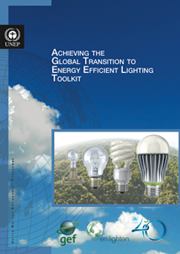
Washington DC, Oct. 16, 2012 - New guidance for lighting efficiency programs will save government resources, speed the transition to energy efficient lighting, boost economies, and mitigate climate change. In a letter sent today, the GEF CEO is announcing the availability of the new UNEP/GEF en.lighten initiative’s Toolkit “Achieving the Transition to Energy Efficient Lighting.” This book is an unparalleled resource for providing guidance for countries to transform their markets to efficient lighting. The Toolkit highlights best practice examples that countries have successfully implemented to move their economies to efficient lighting and mitigate climate change.
Lighting is responsible for 19% of global electricity consumption and if not addressed immediately, global consumption for lighting will grow by 60% by the year 2030. Without significant improvement in efficiency, this growth will have dramatic climate consequences. The phase-out of inefficient lamps is one of the most straightforward and cost effective ways to significantly reduce carbon emissions. However, despite technological improvements most developing countries have not taken steps towards this transition. Countries that have not made the shift may be unsure about how to begin efficiency programs, or lack the necessary capacity and know-how.
In her letter announcing the Toolkit, Dr. Naoko Ishii, GEF CEO and Chairperson said “The GEF, together with UNEP and its international partners, encourages countries to use this Toolkit to protect the environment, save energy, grow their economies, and become more competitive in the global arena.”
The en.lighten initiative is currently working with 46 countries worldwide to develop National Efficient Lighting Strategies based on the best practices reflected in the Toolkit. Partners in the initiative led by UNEP include Philips, Osram, and the National Lighting Test Centre (China).
The content of the Toolkit is presented in practical, action-oriented terms to be utilized by those responsible for drafting policies – environment or energy departments or agencies – but also by public utilities, private sector and civil society organizations.
Dowload the en.lighten Toolkit “Achieving the Transition to Energy Efficient Lighting” and the GEF CEO transmittal letter.
Contact:
Mr. John Diamond
Senior Communication Officer | Spokesperson
Phone +1 202 458 7953
E-mail: jdiamond@thegef.org
Press Release No:16102012
###
About the Global Environment Facility
The GEF unites 182 countries in partnership with international institutions, civil society organizations (CSOs), and the private sector to address global environmental issues while supporting national sustainable development initiatives. Today the GEF is the largest public funder of projects to improve the global environment. An independently operating financial organization, the GEF provides grants for projects related to biodiversity, climate change, international waters, land degradation, the ozone layer, and persistent organic pollutants.
Since 1991, the GEF has achieved a strong track record with developing countries and countries with economies in transition, providing $10.5 billion in grants and leveraging $51 billion in co-financing for over 2,700 projects in over 165 countries. Through its Small Grants Programme (SGP), the GEF has also made more than 14,000 small grants directly to civil society and community based organizations, totaling $634 million. For more information, visitwww.thegef.org.
Stay Connected
Alexandre Pinheiro Rego
Senior Communications Officer
arego@thegef.org